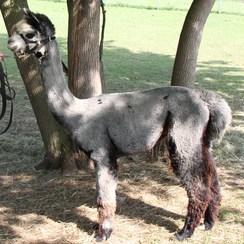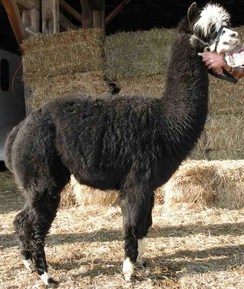|
March 15, 2012
Line Breeding – Husbandry Practice or Inbreeding
Powerful breeding tool and considerations of the method
By: Michael A. Morack

Mary Bell unplanned breeding - excetional traits, discovered at ARI registration.

Renkin unplanned pregnancy - lingering fineness, discovered at ARI registration.

Patagonia planned breeding - Doubled Danko 532 - all around excellence.
When we accept the premise that line breeding is defined as the mating of alpacas with common ancestry then we have also defined inbreeding. The difference appears to be in perception. Inbreeding, especially relating to human mating refers to single generation mating such as father daughter, brother sister, or mother son. In fact, law dictates that marriage between relations closer than third cousins is prohibited. This provides the negative stigmatism associated with inbreeding. Queen Victoria’s offspring made hemophilia so famous it became know as the “Royal disease” and was the result of perpetuating the royal line.
Inbreeding was renamed line breeding to avoid the stigmatism associated with the latter. In our discussion we will use the term line breeding but recognize the terms are interchangeable.
Line breeding is the most potent tool a breeder possesses being used to set traits expressed in a line of animals, in our case alpacas. When we select two alpacas from a specific line we are selecting for all their traits, doubling up on those traits specific to this line. It may be fineness, density, crimp, or brightness as a few.
The drawback or caution occurs in that this selects for all traits not just those of focus. This is the second strength of line breeding. If a line is suspected of a recessive negative trait such as Choanal Atresia (CA) a lethal birth defect, line breeding can help express this trait. Granted we do not want to propagate lethal genes and this is a sure fire method to identify the trait in a line prior to propagation of that line.
Line breeding is helpful in selection of traits that are not easily heritable. Because both animals in a line carry the genetic markers for the difficult trait the opportunity it will be expressed in the pairing increases.
How do we select for responsible line breeding? I want to focus on responsible. There are many instances where a fence collapses unexpectedly and related alpacas take advantage of the breeding opportunity. Unplanned but not necessarily irresponsible, however, when we refer to responsible it is the distance between relations.
Our research and experience suggests some basics. A substantial in depth knowledge of the prepotency or the line of alpacas of interest is necessary. Second, pairings should be no closer than every other generation such as grandmother to grandson, Grandfather to granddaughter. Third, the desired traits of interest need be heritable.
By careful documentation of the prepotency of a line, specific characteristics can be identified as dependable from that line. By line breeding we can reinforce those traits observed in the offspring through multiple and varied pairings.
Selection of the pair minimally a generation apart, provides for some variation in the pairing and still doubling up on the traits of interest. This minimizes, but does not eliminate the possibility of negative recessive genes being expressed.
Heritability is a very important attribute. Without heritable traits, the breeding will successively fail to produce the results of interest.
The last consideration regarding line breeding follows a successful breeding. Successful breeding would be defined as zero negative traits expressed and the trait or traits of interest were propagated in the offspring. The next breeding selection is therefore important. This is called out crossing defined as the breeding of a line of alpacas with an unrelated line of alpacas.
Out crossing at this stage again reduces recessive negative genes being expressed. Therefore, the out cross selection should be an alpaca that expresses the specific trait desired by the line breeding to prevent trait regression. With this type of selection we again want to see the traits expressed in documented offspring or prepotency over a large population. This refers back to the depth of understanding to a line of alpacas under consideration. Under out cross selection only one to a few traits should be focused upon for improvement while attempting to hold all other traits achieved in prior breeding.
In conclusion, line breeding, in breeding, and out crossing are powerful tools in the breeders arsenal to develop the ultimate alpaca. Lack of knowledge about the potency of a line is the real culprit and is the real caution when approaching line breeding.
|